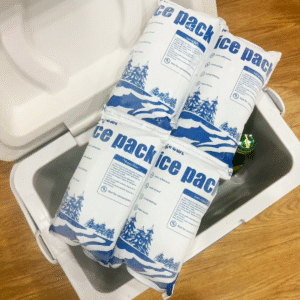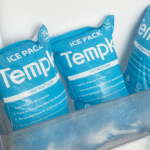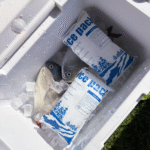Das korrekte Öffnen eines Halyard -Stay -Trockeneis ist entscheidend für die Aufrechterhaltung einer optimalen Integrität der Kaltkette, insbesondere bei Versandtemperatursensitiven wie Pharmazeutika, Biologika, und Lebensmittelprodukte. Das richtige Handling stellt sicher, dass der Eisbeutel effektiv bleibt, Vermeidet Kontamination, und minimiert Sicherheitsrisiken. Dieser Leitfaden führt Sie durch die wesentlichen Schritte zum Öffnen, handhaben, und speichern Sie Ihre Halyard Stay Trockeneisbeutel, Bieten Sie Einblicke aus Best Practices für ein sicheres und effizientes Kaltkettenmanagement aus der Branche.
-
Wie öffne ich einen Halyard, der sicher trockene Eisbeutel bleibt??
-
Was sind die wichtigsten Sicherheitsvorkehrungen beim Umgang mit Trockeneis?
-
Warum ist die ordnungsgemäße Handhabung der Eisbeutel für die Kaltkettenlogistik von entscheidender Bedeutung?
-
Welche Werkzeuge oder Techniken erleichtern das Öffnen des Pakets effizienter und effizienter?
Wie öffne ich einen Halyard, der sicher trockene Eisbeutel bleibt??
Das richtige Öffnen eines Halyard -Trockeneis ist unerlässlich, um das Misshandeln des Trockeneis zu vermeiden, Dies kann Erfrierungen oder einen Aufbau schädlicher Kohlendioxidgas verursachen. Hier finden Sie eine Schritt-für-Schritt-Anleitung, um das sichere Umgang mit Ihrem Eisbeutel sicherzustellen:
Schritt 1: Überprüfen Sie das Rudel
Vor der Öffnung, Überprüfen Sie die Packung visuell auf sichtbare Schäden. Wenn die Verpackung kompromittiert erscheint, mit besonders Vorsicht greifen, da Trockeneis unkontrolliert läuft oder sublimieren kann.
Schritt 2: Bereiten Sie sich auf ein sicheres Handling vor
-
Tragen Sie isolierte Handschuhe: Trockeneis kann schwere Erfrierungen verursachen, wenn sie direkt berührt werden. Tragen Sie beim Umgang mit Trockeneis immer isolierte Handschuhe.
-
Belüftung ist der Schlüssel: Stellen Sie sicher, dass Sie in einem gut belüfteten Bereich arbeiten. Trockeneis unterschwellt zu Kohlendioxidgas, und schlechte Belüftung kann zu einem gefährlichen Gasanbau in geschlossenen Räumen führen.
Schritt 3: Dichtung schneiden
Verwendung einer Schere oder einem scharfen Versorgungsmesser, durch das äußere Siegel des Rudels vorsichtig durchschneiden. Seien Sie vorsichtig, um scharfe Kanten zu vermeiden, die das Rudel beschädigen oder Verletzungen verursachen könnten.
Schritt 4: Entfernen Sie das Trockeneis
Sobald das Paket geöffnet ist, Entfernen Sie das Trockeneis vorsichtig mit Ihren isolierten Handschuhen. Legen Sie das Eis in einen Behälter, der für die sichere Handhabung und Lagerung von Trockeneis ausgelegt ist.
Warum ist der richtige Umgang mit Trockeneis wichtig??
Trockeneis spielt eine entscheidende Rolle in der kalten Kettenlogistik, insbesondere für verderbliche Güter, Arzneimittel, und Impfstoffe. Eine unsachgemäße Handhabung kann zu Kontamination führen, Verderb, und gefährliche Sicherheitsvorfälle. Zusätzlich, Die Sublimation von Trockeneis erzeugt Kohlendioxidgas, was in hohen Konzentrationen gefährlich sein kann.
Trockeneisverbrennungen und Sicherheitsrisiken
Trockeneis kann schwere Verbrennungen verursachen, wenn sie nicht richtig behandelt werden. Verwenden Sie immer Handschuhe und achten Sie besonders darauf, dass Sie Hautkontakt vermeiden. Außerdem, Unsachgemäßes Handling kann zu Druckaufbau in Behältern führen, das kann gefährlich sein.
Welche Werkzeuge und Techniken erleichtern das Öffnen des Eisbeutels?
Einen Halyard zu öffnen, bleiben Sie sicher und effizient, Die richtigen Werkzeuge und Techniken sind unerlässlich:
Empfohlene Werkzeuge
-
Isolierte Handschuhe: Wesentlich zum Schutz der Hände vor Verbrennungen oder Erfrierungen.
-
Versorgungsmesser: Wird verwendet, um die Siegel der Packung genau zu schneiden, Sicherstellen, dass kein Schaden angerichtet ist.
-
Belüfteter Arbeitsbereich: Minimiert die mit Trockeneis -Sublimation verbundenen Risiken.
| Werkzeug | Zweck | Warum ist es wichtig |
|---|---|---|
| Isolierte Handschuhe | Trockeneis sicher zu handhaben | Verhindert Erfrierungen und Hautverletzungen |
| Versorgungsmesser | Zum Schneiden der Packung der Packung | Sichert präzise, sichere Öffnung ohne Beschädigung |
| Gut belüfteter Gebiet | Für die richtige Sublimation von Trockeneis | Reduziert den CO2 -Gasaufbau, Sicherheit gewährleisten |
Best Practices für die Öffnung:
-
Vorsichtig um den Rudel herumschneiden: Vermeiden Sie tiefe Schnitte, die das Trockeneis im Inneren beschädigen könnten.
-
Schnell aber sicher arbeiten: Einmal geöffnet, Übertragen Sie das Trockeneis unverzüglich in einen geeigneten Behälter.
-
Speicherspitze: Geben Sie immer Trockeneis in Behälter, die Sublimation ermöglichen, ohne es fest zu versiegeln, um eine Bannungsbeteiligung zu vermeiden.
Wie lagere ich Halyard nach dem Öffnen trockene Eisbeutel??
Nach dem Öffnen eines Halyard -Trockeneis, Es ist wichtig, das verbleibende Trockeneis ordnungsgemäß zu speichern, um seine kühlende Wirksamkeit aufrechtzuerhalten. So wie:
Schritt 1: Wählen Sie den richtigen Speicherbehälter
Verwenden Sie einen gut isolierten Behälter, mit dem Trockeneis mit einer kontrollierten Geschwindigkeit untermauert werden kann. Behälter speziell für die Lagerung von Trockeneis sind ideal sind, während sie die Geschwindigkeit reduzieren, mit der das Eis untermauert, seine Wirksamkeit erweitern.
Schritt 2: Stellen Sie eine ordnungsgemäße Belüftung sicher
Lagern Sie immer Trockeneis in einem Raum, der ausreichend belüftet ist. Geschlossen, Luftdichte Behälter können einen gefährlichen Druckanbau verursachen, was zu potenziellen Brüchen führt.
Schritt 3: Vermeiden Sie direkten Kontakt
Gehen Sie niemals mit trockenen Eis direkt mit Ihren nackten Händen um. Verwenden Sie immer isolierte Handschuhe, und vermeiden Sie es, das Eis zu berühren, es sei denn, dies ist absolut notwendig.
Warum ist Trockeneisspeicher so wichtig??
Die ordnungsgemäße Trockeneisspeicherung wirkt sich erheblich auf die Wirksamkeit Ihrer Kaltkette aus. Sicherstellen, dass das Trockeneis langsam innerhalb eines Isolierten untermauert, Gut belüfteter Behälter hilft dabei, die gewünschte Temperatur für längere Zeiträume zu erhalten.
| Best Practices für Speicher | Warum ist es wichtig |
|---|---|
| Isolierte Behälter | Verlangsamt die Sublimation und erhält kalt |
| Belüftete Räume | Verhindert CO2 -Aufbau und Containerbruch |
| Nicht leitende Behälter | Reduziert das Risiko eines gefährlichen Drucks |
Zusätzliche Sicherheitsvorkehrungen für den Umgang mit Trockeneis
Der Umgang mit Trockeneis erfordert mehr als nur die richtigen Werkzeuge; Es erfordert auch ein ständiges Bewusstsein für Sicherheitsprotokolle, um Unfälle zu vermeiden.
-
Sublimationsraten überwachen: Behalten Sie den Überblick darüber, wie schnell Trockeis untermauert, um unnötigen Abfälle zu vermeiden, und sicherzustellen, dass die Kühlkapazität beibehalten wird.
-
Trackeistemperatur: Für kritische Sendungen, Erwägen Sie, Temperaturverfolgungsgeräte zu verwenden, um den Zustand Ihres Trockeneis während des Transitprozesses zu überwachen.
Fallstudie: Ein Pharmaunternehmen verbesserte seine Logistik durch ordnungsgemäßes Umgang mit Trockeneis, Verderbraten durch Verderben durch 12% während die Integrität temperaturempfindlicher Produkte sichergestellt wird.
2025 Trends der Kaltkette Branche
Neueste Entwicklungen im Trockeneisverbrauch
In der Kaltketten -Logistikindustrie werden schnelle Innovationen beim Handling mit Trockeneis verzeichnet, vor allem mit Fortschritten in Materialien und Verpackungen. Neue umweltfreundliche Isolationsmaterialien, zusammen mit fortschrittlichen Überwachungssystemen, verbessern die Effizienz und Sicherheit von Trockeneis während des Transports.
Trends und Innovationen:
-
Verbesserte Isolationsmaterialien: Es werden fortgeschrittene Materialien entwickelt, um die Sublimationsraten zu senken und die Umweltverträglichkeit zu verbessern.
-
Trockeneisverfolgung: IoT-Sensoren, die in Trockeneisbehälter integriert sind, ermöglichen eine Echtzeitüberwachung, sicherzustellen, dass Trockeneis während des gesamten Transports wirksam bleibt.
-
Nachhaltige Alternativen: Die Suche nach umweltfreundlichen Alternativen zum Trockeneis verstärkt sich, Mit mehreren vielversprechenden Materialien, die den Markt betreten.
Häufig gestellte Fragen (FAQ)
Q1: Wie lagere ich Trockeneis für den langfristigen Gebrauch??
Trockeneis in einem gut belüfteten Speicher aufbewahren, Isolierter Behälter, Sicherstellen, dass der Behälter nicht luftdicht ist, um Druckanbau zu verhindern.
Q2: Kann ich normale Handschuhe verwenden, um Trockeneis zu behandeln??
NEIN, Sie müssen isolierte Handschuhe verwenden, die speziell für den Umgang mit Trockeneis entwickelt wurden, um Erfrierungen zu verhindern.
Q3: Wie schnell macht Trockeis sublimieren?
Trockeneis sublimiert mit einer Geschwindigkeit von 5-10 Pfund alle 24 Stunden abhängig von der Isolierung und Umweltbedingungen des Behälters.
Schlussfolgerung und umsetzbare Tipps
Das ordnungsgemäße Öffnen und Umgang mit einem Halyard-Aufenthalt von Trockeneis ist unerlässlich, um den sicheren Transport und die Lagerung von temperaturempfindlichen Waren sicherzustellen. Durch die Befolgen dieser einfachen Schritte - mit isolierten Handschuhen unter Verwendung, Sorgfältig das Rudel schneiden, und Speichern von Trockeneis in einem gut belüfteten Behälter-Sie können sicherstellen, dass Ihre kalte Kette intakt bleibt.
Nächste Schritte:
-
Stellen Sie immer sicher, dass Trockeneis in isoliert gelagert wird, nicht leitende Behälter.
-
Überwachen Sie die Sublimationsraten regelmäßig, um Abfälle und Ineffizienz zu vermeiden.
-
Verwenden Sie Trockeneis -Tracking -Systeme für kritische Sendungen, um Sicherheit und Effektivität zu gewährleisten.
Über Tempk
Und Tempk, Wir sind spezialisiert auf die Bereitstellung modernster Kaltketten-Logistiklösungen, die den sicheren und effizienten Transport von temperaturempfindlichen Produkten gewährleisten. Unser Fachwissen in Bezug, von Anfang bis Ende.
Benötigen Sie Expertenberatung? Wenden Sie sich an uns nach maßgeschneiderten Logistiklösungen für kalte Kette.
























